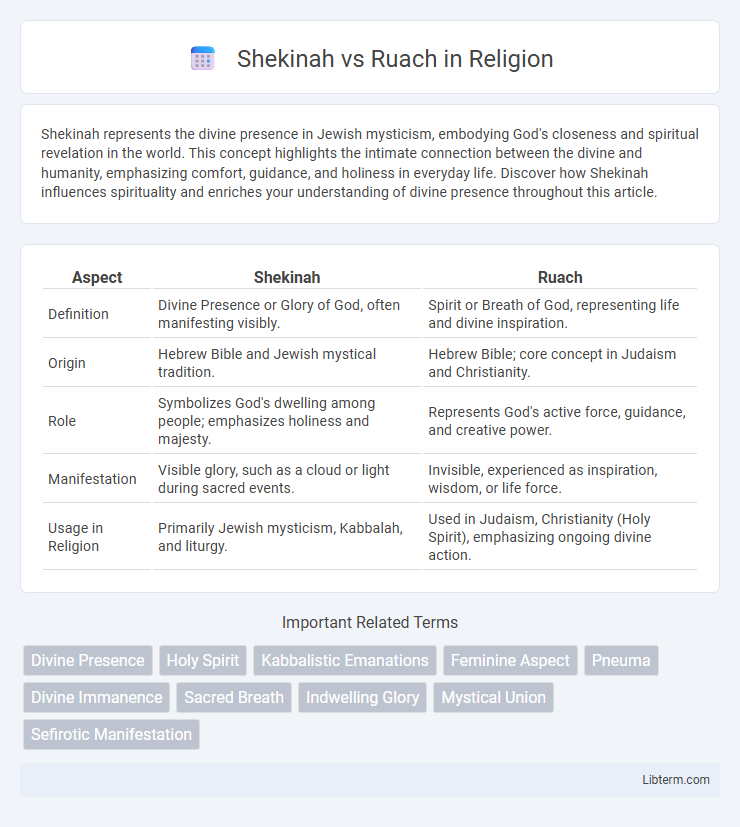Shekinah represents the divine presence in Jewish mysticism, embodying God's closeness and spiritual revelation in the world. This concept highlights the intimate connection between the divine and humanity, emphasizing comfort, guidance, and holiness in everyday life. Discover how Shekinah influences spirituality and enriches your understanding of divine presence throughout this article.
Table of Comparison
| Aspect | Shekinah | Ruach |
|---|---|---|
| Definition | Divine Presence or Glory of God, often manifesting visibly. | Spirit or Breath of God, representing life and divine inspiration. |
| Origin | Hebrew Bible and Jewish mystical tradition. | Hebrew Bible; core concept in Judaism and Christianity. |
| Role | Symbolizes God's dwelling among people; emphasizes holiness and majesty. | Represents God's active force, guidance, and creative power. |
| Manifestation | Visible glory, such as a cloud or light during sacred events. | Invisible, experienced as inspiration, wisdom, or life force. |
| Usage in Religion | Primarily Jewish mysticism, Kabbalah, and liturgy. | Used in Judaism, Christianity (Holy Spirit), emphasizing ongoing divine action. |
Understanding Shekinah: The Divine Presence
Shekinah represents the dwelling or settling of the divine presence of God, often depicted as a radiant light or cloud symbolizing God's glory in Jewish mysticism. Unlike Ruach, which denotes the spirit or breath of God reflecting divine energy and life force, Shekinah emphasizes God's immanence and intimate presence among humanity. Understanding Shekinah involves recognizing this sacred manifestation as a bridge connecting the divine to the physical world, highlighting God's closeness and protective presence.
Exploring Ruach: The Spirit of God
Ruach, the Hebrew word for "spirit" or "wind," represents the dynamic and life-giving breath of God, often depicted as a vital force sustaining creation and inspiring prophetic revelation. Unlike Shekinah, which emphasizes God's manifest presence or dwelling among His people, Ruach highlights God's active, empowering movement within individuals and communities, enabling spiritual insight, wisdom, and transformation. Exploring Ruach reveals its integral role in animating life, guiding moral consciousness, and fostering an intimate, ongoing relationship between the Divine and humanity.
Shekinah in Jewish Tradition
Shekinah in Jewish tradition represents the divine presence of God dwelling among His people, often symbolizing God's immanence and sanctity in the earthly realm. It contrasts with Ruach, which denotes the spirit or breath of God, encompassing divine inspiration and life force. Emphasizing Shekinah highlights its role in religious rituals, sacred spaces like the Tabernacle and Temple, and its manifestation in moments of communal prayer and repentance.
Ruach in Biblical Context
Ruach, a Hebrew term translated as "spirit," "wind," or "breath," signifies the dynamic and life-giving presence of God throughout the Bible, especially in the Old Testament. It represents God's power and influence, often described as moving over the waters in Genesis 1:2 and inspiring prophecy and wisdom in figures like Moses and the prophets. Unlike Shekinah, which specifically refers to the divine glory dwelling among people, Ruach emphasizes the invisible, empowering force that sustains creation and animates human existence.
Key Differences Between Shekinah and Ruach
Shekinah refers to the divine presence or dwelling of God, often depicted as a radiant cloud or light symbolizing God's immanence in the world, while Ruach denotes the Spirit or breath of God, representing divine life, power, and movement. Shekinah emphasizes God's tangible manifestation among people, especially in sacred spaces such as the Tabernacle or Temple, whereas Ruach highlights God's active force inspiring creation, prophecy, and renewal. The key difference lies in Shekinah's association with God's settled presence contrasted with Ruach's role as dynamic, animating spiritual energy.
Symbolism and Representation: Shekinah vs Ruach
Shekinah symbolizes the divine presence and glory of God as a radiant, feminine aspect encompassing sanctity and dwelling among believers, often depicted as a luminous cloud or light. Ruach represents the spirit or breath of God, embodying life, wind, and dynamic movement, highlighting God's power and inspiration within creation. Together, Shekinah emphasizes divine immanence and nurturing presence, while Ruach conveys God's active force and spiritual vitality.
Shekinah and Ruach in Kabbalistic Thought
Shekinah in Kabbalistic thought represents the divine feminine presence of God dwelling within the world, embodying immanence and spiritual manifestation. Ruach is understood as the divine spirit or breath, symbolizing the animating force and intermediate aspect between the divine essence (Ein Sof) and human souls. The relationship between Shekinah and Ruach highlights a dynamic interplay where Shekinah grounds divine presence in creation, while Ruach facilitates communication and spiritual awakening within the human experience.
Theological Interpretations: Shekinah vs Ruach
Shekinah represents the visible, divine presence of God dwelling among His people, often symbolizing God's glory and holiness in Jewish and Christian theology. Ruach, meaning "spirit" or "breath," refers to the dynamic, life-giving force of God that empowers, inspires, and renews believers. Theological interpretations distinguish Shekinah as God's manifest presence, while Ruach signifies the active, ongoing spiritual influence and power within individuals.
Shekinah and Ruach in Worship and Mysticism
Shekinah represents the divine presence dwelling among worshippers, symbolizing God's immanence and sanctification during sacred rituals and mystical experiences. Ruach, often translated as "spirit" or "breath," signifies the dynamic, life-giving force that inspires prophetic revelation and spiritual renewal within mystical practices. In worship, Shekinah emphasizes God's manifested holiness, while Ruach drives the transformative energy that animates individual and communal encounters with the divine.
Modern Perspectives on Shekinah and Ruach
Shekinah and Ruach represent distinct yet interconnected concepts in Jewish mysticism, with Shekinah embodying the divine presence dwelling among humanity, while Ruach signifies the spirit or breath of God inspiring life and prophecy. Modern perspectives emphasize Shekinah as a symbol of feminine divine energy and social justice, highlighting its role in contemporary spirituality and feminist theology. Ruach continues to be viewed as a dynamic force of creativity and transformation, integral to personal empowerment and the ongoing dialogue between humanity and the divine.
Shekinah Infographic

 libterm.com
libterm.com